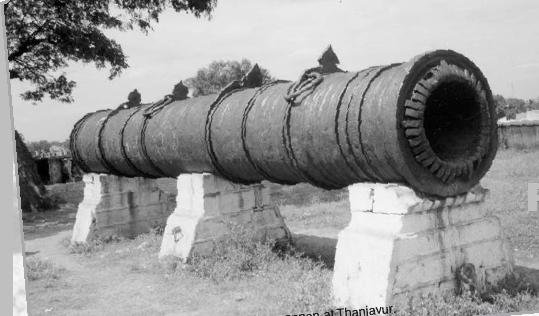One of the interesting heritage sites in Thanjavur city, Tamil Nadu near the main bus stand and Thanjavur palace is Beerangi Medu where a Nayak era cannon is installed . Not that many visitors come to this site for reasons of poor publicity, official negligence and above all encroachments that mar this listed heritage site. Any way, it is mentioned in the media that the government has in the recent past allocated Rs,21 lakhs to repair the site and make it attractive for the visitors. The Smart City Project has been going on in the last few years.
 |
| Tanjore cannon thanjaimainthan.blogspot.com |
 |
| Forge welded iron cannon, Thanjavur rarebooksocietyofindia.org/ |
Placed atop 25 ft tall structure, once part of a bastian (?) of an old fort is a huge 22- 25 ton cannon measuring roughly 25ft. (outer diameter 37 inches; inner diameter 25 inches) facing the street. The huge cannon, believed to be one of the powerful cannons in South India, is capable of firing 1000 kg cannon ball with a long range. Perched strategically atop the old outer fortification facing the East Rampart (Keezha Alangam; close to the East gate bazaar area and Vellai Pillayar kovil) the gunner could spot enemy movement in the open range and act accordingly.
 |
| king Raghunatha nayak of Tanjore, TN facebook.com |
Above image: Raghunatha Nayak (1600–1645 A.D of Thanjavur Nayak Dynasty. Raja of Thanjavur (Reign 1600–1634) son of king Achuthappa Nayak; ascended throne in 1614. His successor was Vijaya Raghava Nayak. A patron of literature, art, languages and Carnatic music Raghunatha Nayak strengthened his army by including artillery troops to handle cannons, Artillery power was game changer in the wars in those days.........
It is believed the Tanjore cannon was cast during the time of Raghunatha Nayak (1600–1645 A.D of Thanjavur Nayak Dynasty. Some historians believe this huge cannon was either cast at Kollumedu near Thanjavur or in the Manojipatti, near Thanjavur, famous for iron working.
Others are of the view that the cannon was made by Danes in Denmark. Th Danes leased out the land in Tarangambadi (Tranquebar) in Nagapattinam dist., TN to build a Danish settlement with a fort (Fort Dansborg along the Coromandel coast; a famous tourist spot).
Thanjavur was the center of making high quality bronze idols of gods, etc (using the lost -wax process and the artisans had excellent skills in metallurgy and in the making of alloys. The Thanjavur cannon is a forge-welded component comprising numerous ring assemblies with 43 long iron plates The heavy cannon was placed in 1620 on the fort near the east entrance by king Raghunath Nayak. and locally it is known as Rajagopala Beerangi. Though reliable records are not available about the Tanjore Cannon, unsubstantiated information mentioned about the presence in the Thanjavur fort of an object referred to as a “fire-breathing barrel shaped weapon.” The cannon's origin is subject to dispute.
With respect to metallurgy and structure of this famous cannon, research workers mention that the fabrication of the cannon was done by forge welding (i.e.,forging together of rings assemblies of welded iron) to join the layers of ring. The purpose was to further strengthen it. Both the barrel and chamber parts were carefully designed. The barrel needed to be tough and not deformable. Its main function was to contain the lateral exhaust of the gas (from the explosion of the gunpowder) and, in this process, the projectile was pushed out.
In the case of the chamber rear side had to be tightly closed to withstand the gunpowder explosion. because it was subject to higher gas pressures than the barrel due to gunpowder explosion at the point of ignition. Additional ring assemblies at the rear end means extra strength to the cannons when fired.This cannon is a muzzle-loading type cannon, wherein the gunpowder and the projectile objects are loaded from the muzzle (i.e. front end) of the cannon.
 |
| Monster Gun of Tanjore agefotostock.com |
Above image: Monster Gun of Tanjore (Thanjavur), Tamil Nadu, India. This enormous iron cannon was built during the reign of Raghunatha Nayak (17th century), and is thought to be one of the largest in the world,-The Rajah’s old gun, Tanjore, India Creator Not Known. Contributor Gifford M. Mast. UC Riverside, California Museum of Photography
https://www.navrangindia.in/2020/03/thanjavur-cannon-rajagopalaswami_6.html
https://home.iitk.ac.in/~bala/journalpaper/journal/journalpaper_40.pdf
https://rarebooksocietyofindia.org/postDetail.php?id=









